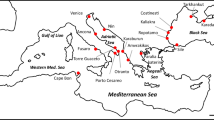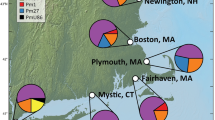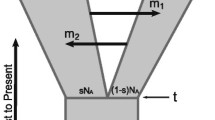Abstract
Two centuries of historical, archaeological, paleontological, geological, oceanographical and biological data conclusively indicate that the periwinkle snail Littorina littorea was introduced to North America from Europe either by Norse explorers 1000 years ago or by European colonists after 1840. Available genetic data do not indicate ancient divergence of North American and European L. littorea and thus do not challenge all other evidence that it was introduced from Europe by humans.
Similar content being viewed by others
References
Bird JB (1968) Littorina littorea: occurrence in a northern Newfoundland beach terrace, predating Norse settlements. Science 159:114
Carlton JT (1992) Introduced marine and estuarine mollusks of North America: an end-of-the-20th-century perspective. J Shellfish Res 11:489–505
Carlton JT (2003) Community assembly and historical biogeography in the North Atlantic Ocean: the potential role of human-mediated dispersal vectors. Hydrobiologia 503:1–8
Chapman JW, Carlton JT, Bellinger MR, Blakeslee AMH (2007) Premature refutation of a human-mediated marine species introduction: the case history of the marine snail Littorina littorea in the northwestern Atlantic. Biol Inv 9. doi: 10.1007/s10530-007-9098-9
Clarke AH (1971) Littorina littorea, native or introduced? Biologist 53:160–162
Colautti RI, Manca M, Viljanen M, Ketelaars HAM, Burgi B, MacIsaac HJ, Heath DH. (2005) Invasion genetics of the Eurasian spiny waterflea: evidence for bottlenecks and gene flow using microsatellites. Mol Ecol 14:1869–1879
Coyer JA, Hoarau G, Skage M, Stam WT, Olsen JL (2006) Origin of Fucus serratus (Heterokontophyta; Fucaceae) populations in Iceland and the Faroes: a microsatellite-based assessment. Eur J Phycol 41:235–246
Cunningham CW (2007) How to use genetic data to distinguish between natural and human-mediated introduction of Littorina littorea to North America. Biol Inv 9. doi: 10.1007/s10530-007-9099-8
Dawson MN, Gupta AS, England MH (2005) Coupled biophysical global ocean model and molecular genetic analyses identify multiple introductions of cryptogenic species. Proc Natl Acad Sci 102:11968–11973
Hickey AJR, Lavery SD, Eyton SR, Clements KD (2004) Verifying invasive marine fish species using molecular techniques: a model example using triplefin fishes (Family Tripterygiidae). N Z J Mar Freshwater Res 38:439–446
Mackie JA, Keough MJ, Christidis L (2006) Invasion patterns inferred from cytochrome oxidase I sequences in three bryozoans, Bugula neritina, Watersipora subtorquata, and Watersipora arcuata. Mar Biol 149:285–295
McIvor L, Maggs CA, Provan J, Stanhope MJ. (2001) rbcL sequences reveal multiple cryptic introductions of the Japanese red alga Polysiphonia harveyi. Mol Ecol 10:911–919
Nielsen R, Wakeley J (2001) Distinguishing migration from isolation: a Markov chain Monte Carlo approach. Genetics 158:885–896
Reid DG (1996) Systematics and evolution of Littorina. The Ray Society, The Dorset Press, Dorchester, Dorset, England
Wares JP, Goldwater DS, Kong BY, Cunningham CW (2002) Refuting a controversial case of a human-mediated marine species introduction. Ecol Lett 5:577–584
Author information
Authors and Affiliations
Corresponding author
Rights and permissions
About this article
Cite this article
Chapman, J.W., Blakeslee, A.M.H., Carlton, J.T. et al. Parsimony dictates a human introduction: on the use of genetic and other data to distinguish between the natural and human-mediated invasion of the European snail Littorina littorea in North America. Biol Invasions 10, 131–133 (2008). https://doi.org/10.1007/s10530-007-9115-z
Published:
Issue Date:
DOI: https://doi.org/10.1007/s10530-007-9115-z




